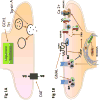Emerging common molecular pathways for primary dystonia
- PMID: 23893453
- PMCID: PMC3838975
- DOI: 10.1002/mds.25547
Emerging common molecular pathways for primary dystonia
Abstract
The dystonias are a group of hyperkinetic movement disorders whose principal cause is neuron dysfunction at 1 or more interconnected nodes of the motor system. The study of genes and proteins that cause familial dystonia provides critical information about the cellular pathways involved in this dysfunction, which disrupts the motor pathways at the systems level. In recent years study of the increasing number of DYT genes has implicated a number of cell functions that appear to be involved in the pathogenesis of dystonia. A review of the literature published in English-language publications available on PubMed relating to the genetics and cellular pathology of dystonia was performed. Numerous potential pathogenetic mechanisms have been identified. We describe those that fall into 3 emerging thematic groups: cell-cycle and transcriptional regulation in the nucleus, endoplasmic reticulum and nuclear envelope function, and control of synaptic function. © 2013 Movement Disorder Society.
Keywords: DYT genes; cell cycle; endoplasmic reticulum; nuclear envelope; synaptic function.
© 2013 Movement Disorder Society.
Conflict of interest statement
Relevant conflicts of interest/financial disclosures: Nothing to report.
Figures



Similar articles
-
Advances in molecular and cell biology of dystonia: Focus on torsinA.Neurobiol Dis. 2019 Jul;127:233-241. doi: 10.1016/j.nbd.2019.03.007. Epub 2019 Mar 12. Neurobiol Dis. 2019. PMID: 30877032 Review.
-
Emerging and converging molecular mechanisms in dystonia.J Neural Transm (Vienna). 2021 Apr;128(4):483-498. doi: 10.1007/s00702-020-02290-z. Epub 2021 Jan 1. J Neural Transm (Vienna). 2021. PMID: 33386558 Review.
-
Primary dystonia: molecules and mechanisms.Nat Rev Neurol. 2009 Nov;5(11):598-609. doi: 10.1038/nrneurol.2009.160. Epub 2009 Oct 13. Nat Rev Neurol. 2009. PMID: 19826400 Free PMC article. Review.
-
Aberrant cellular behavior of mutant torsinA implicates nuclear envelope dysfunction in DYT1 dystonia.J Neurosci. 2004 Mar 17;24(11):2593-601. doi: 10.1523/JNEUROSCI.4461-03.2004. J Neurosci. 2004. PMID: 15028751 Free PMC article.
-
Review: genetics and neuropathology of primary pure dystonia.Neuropathol Appl Neurobiol. 2012 Oct;38(6):520-34. doi: 10.1111/j.1365-2990.2012.01298.x. Neuropathol Appl Neurobiol. 2012. PMID: 22897341 Review.
Cited by
-
Dystonia: Five new things.Neurol Clin Pract. 2015 Jun;5(3):232-240. doi: 10.1212/CPJ.0000000000000128. Neurol Clin Pract. 2015. PMID: 26124980 Free PMC article.
-
Striatal cholinergic dysfunction as a unifying theme in the pathophysiology of dystonia.Prog Neurobiol. 2015 Apr;127-128:91-107. doi: 10.1016/j.pneurobio.2015.02.002. Epub 2015 Feb 17. Prog Neurobiol. 2015. PMID: 25697043 Free PMC article. Review.
-
Inhibition of endoplasmic reticulum stress reverses synaptic plasticity deficits in striatum of DYT1 dystonia mice.Aging (Albany NY). 2021 Aug 16;13(16):20319-20334. doi: 10.18632/aging.203413. Epub 2021 Aug 16. Aging (Albany NY). 2021. PMID: 34398825 Free PMC article.
-
Blepharospasm, Oromandibular Dystonia, and Meige Syndrome: Clinical and Genetic Update.Front Neurol. 2021 Mar 29;12:630221. doi: 10.3389/fneur.2021.630221. eCollection 2021. Front Neurol. 2021. PMID: 33854473 Free PMC article. Review.
-
Dystonia as a network disorder: what is the role of the cerebellum?Neuroscience. 2014 Feb 28;260:23-35. doi: 10.1016/j.neuroscience.2013.11.062. Epub 2013 Dec 11. Neuroscience. 2014. PMID: 24333801 Free PMC article. Review.
References
-
- Phukan J, Albanese A, Gasser T, Warner T. Primary dystonia and dystonia-plus syndromes: clinical characteristics, diagnosis, and pathogenesis. Lancet Neurol. 2011;10:1074–1085. - PubMed
-
- Ozelius L, Kramer P, Page CE, et al. The early-onset torsion dystonia gene (DYT1) encodes an ATP-binding protein. Nature Genet. 1997;17:40–48. - PubMed
-
- Hanson PI, Whiteheart SW. AAA+proteins: have engine will work. Nat Rev Mol Cell Biol. 2005;6:519–529. - PubMed
-
- Kock N, Naismith TV, Boston HE, et al. Effects of genetic variations in the dystonia protein torsinA: identification of polymorphism at residue 216 as protein modifier. Hum Mol Genet. 2006;15:1355–1364. - PubMed
-
- Augood SJ, Penney JB, Friberg IK, et al. Expression of the early onset torsion dystonia gene (DYT1) in human brain. Ann Neurol. 1998;43:669–673. - PubMed
Publication types
MeSH terms
Substances
Grants and funding
LinkOut - more resources
Full Text Sources
Other Literature Sources

